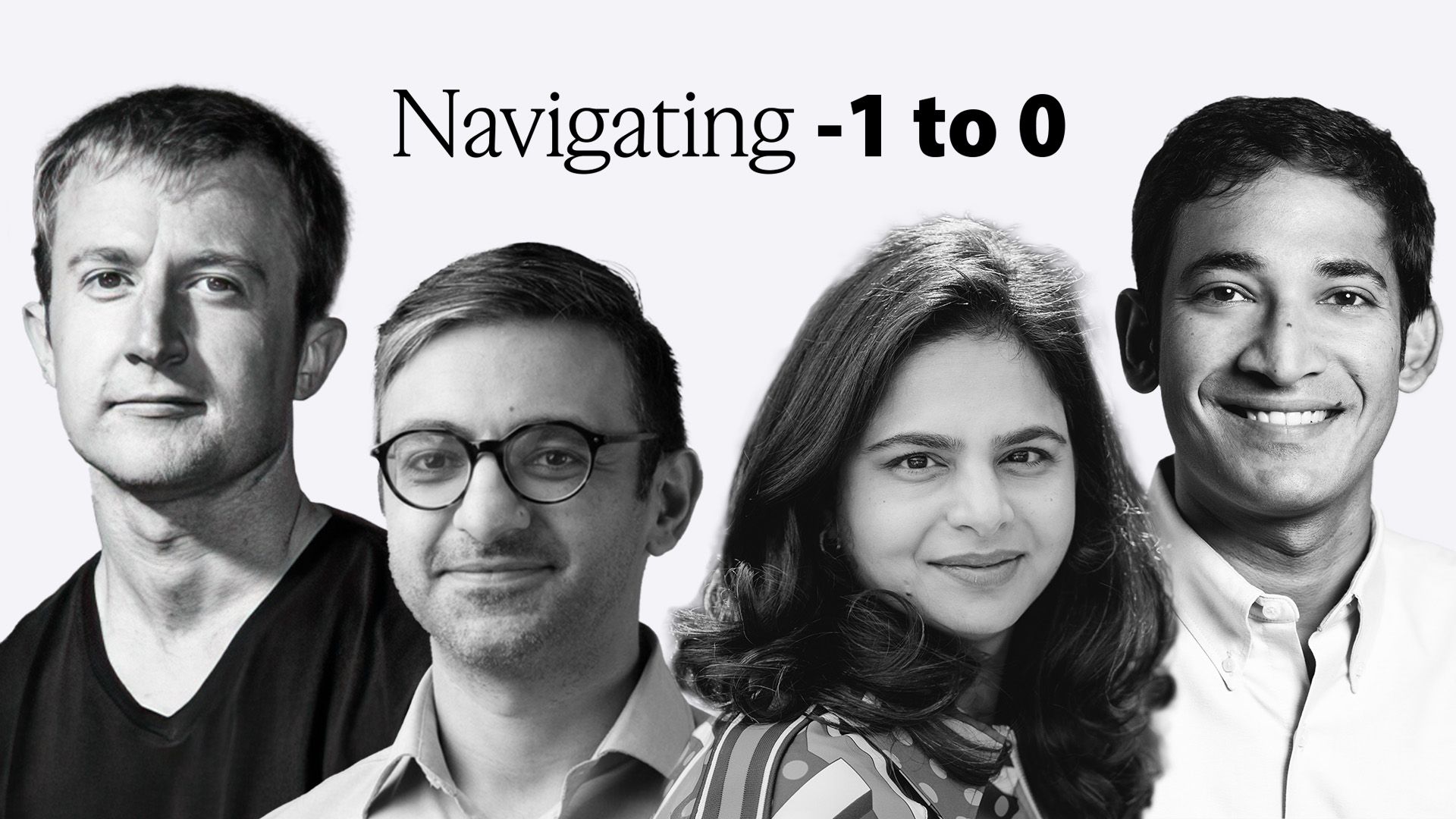How to Navigate -1 to 0: Advice From the Experts
Four experts share what it takes to get through a critical stage of company building.

Applications are now open for the Fall 2024 Founder Fellowship—apply here by August 9th!
South Park Commons is a community dedicated to helping its members through the critical -1 to 0 stage. But what does that stage look like for founders, and what are best practices for navigating it?
To answer those questions, SPC brought together four experts to discuss -1 to 0 in the founder journey: Avichal Garg, Co-founder and Managing Partner at Electric Capital; Peter Reinhardt, Co-founder and CEO of Charm Industrial and former Co-founder and CEO of Segment; Ruchi Sanghvi, Founder and Partner at South Park Commons; and Aditya Agarwal, Partner at South Park Commons and former CTO of Dropbox.
We encourage you to watch the full panel discussion, but we've summarized the key quotes and insights below.
Defining -1 to 0
Avichal: 0 to 1 is the idea of trying to get Product-Market Fit. And 1 to N is scaling a business. So what is -1 to 0? It's the idea of: what do I even do? For a lot of people 0 to 1 or 1 to N is how do I get from A to B? -1 to 0 is: how do I figure out the right B? Figuring out the right B is a muscle that atrophies. And for a lot of people, it's not a skill they ever cultivate.
Peter: Segment and Charm Industrial were very different experiences in -1 to 0. At Segment, we were a team that wanted to be together. We were roommates at MIT. -1 to 0 was about finding people we were mutually committed to and iterating through ideas.
With Charm, it was more about noticing a problem. I was trying to buy carbon offsets at Segment and I made some purchases and a year later I was like, wait a second, I don't think any of these actually did anything. This is all just a ruse. Then I fell down that rabbit hole and -1 to 0 experience of problem discovery.
Ruchi: When you look at successful companies, nobody figures things out in three months. It's a really long time to say, "I'm going to think about a problem, I'm going to figure out how to convert that problem into a company, I'm going to find people to work with and I'm going sit in this loop for a year." It's a really shitty place to be in mentally. The initial idea for SPC was to find 10 people who were exactly like me, who wanted to start their own companies, who had been pretty successful in the past, but still had that hunger to do more. And we could build this muscle that Avichal is talking about, how to figure out B.
Attachment vs Conviction
Peter: There are two distinct stages [in -1 to 0]. First is identifying a problem and having conviction that's a problem you really want to solve. Second is an idea for how you're going to solve that and having conviction that's actually the right solution. A lot of people get attached to the product idea before they actually have conviction that there's really a problem there. They get mixed up between attachment and conviction.
Avichal: Too often people conflate thinking, "this would be an awesome open source project" or "this would be an awesome book" with "this is a venture-backable idea." Another common case is you're pursuing an idea that even if you build the right product, nobody cares. Too often people are not deliberate about picking good markets and understanding market structure.
The operating assumption you want in a -1 to 0 environment is: if I found a problem and I think I have a good product solution for it, assume that somebody has already solved that problem and there's a reason your solution doesn't exist yet.
I think markets tend to be efficient. That's not saying somebody has actually done it, but start with that assumption. And if it turns out nobody's actually solved it, then like maybe you're onto something, right? That happens, but more often than not, it's actually the case that somebody tried. And you can go find that founder. A lot of times those founders just want to spare you the pain of going through the same journey that they went through and wasting two years of your life.
Plans Are Nothing, Planning Is Everything
Peter: I think TAM analysis is bullshit. I think we got lucky at Segment. If you look at the total number of software companies founded over time, it explodes all through the 2010s. Who does Segment sell to? Companies building software products. We were just riding this massive underlying tidal wave. And so that was luck.
I think Charm was a little more thoughtful. When we started it in 2018, you could read all the analysis, which was like, carbon removal's going to have to be huge. And so if you do the same thing, you're like, okay, it's gonna grow at this staggering rate for the next 30 years. I don't know where it's gonna come from, but there's probably buyers. So bet on those secular trends or underlying tidal waves.
Ruchi: I also think TAM analysis is bullshit, but the thing that I think is really useful and a really good indicator is to identify how many buyers there are. So for example, if you're going sell a product for $10, how many buyers are there in the market and what percentage of those buyers are you going to capture?
So I almost think the number of buyers is more important than, oh, this is a $4 billion market, or this is like a $5 billion market. That way you can see who are the types of people you're selling products to. Are they prosumers? Are they small businesses? Will enterprise buy it? What is the potential price point? And does that make sense? And in most cases it will not make sense. And that's where the graveyard of companies lie.
Avichal: The number that comes out for the TAM, totally useless. The process of going through the exercise of who are the customers, how many customers are there, what's the market segmentation, how much do they pay for stuff? That process gives you a lot of insight into what's happening. If you operate under the assumption that markets tend to be efficient, the reason that something can exist where it previously could not exist is because something in the world has changed.
And so the job of the analysis is not to produce the TAM number, but to understand the market sufficiently deeply so you can identify the thing that's changed in the world and you have a concrete answer to why is now a thing possible, when it just didn't make sense five years ago.
Identifying Market Opportunities
Avichal: There are five answers to the Why Now question. One is that there's some sort of regulatory change, like the ACA/Obamacare. The others are consumer behavior has changed, a platform has emerged, there's a new technology change or there's a new business model. You can look at every startup in history and point at one of these five.
Ruchi: There is a sixth. There are a lot of markets where products have an NPS score of 0. It's not negative and it's not positive, it's 0. And the reason it's 0 is because the industry is nascent, or the product itself is really shitty, but people absolutely need it. If you find those opportunities, you can also find a pretty great market.
Aditya: I have a hypothesis that when something good happens, the other person on the other side immediately knows it. It sets off: this is a pain point, this product solves it. And you'll know it pretty quickly when something is really good.
Avichal: In a weird way, success is easier than not-success. Anybody who's been inside an organization that has had Product-Market Fit, it feels like you can't lose. It's not any less stressful, but the stress goes from: is this working? Are we gonna fail? To, I'm not gonna realize the full potential of this. This could be worth a hundred billion dollars and I might screw it up. Then you actually are onto something.
Peter: I think it is necessary still to go through the process, when you don't get the easy Yes. That doesn't mean you just walk away. Because the things that you're going to learn in the details of why not are actually relevant.
Avichal: The other high-conviction belief I have about -1 to 0 is it's as much an introspective exercise as it is a market exercise. Every great founder I've met that's ended up doing something that was durable and lasting, the company and the organization and the product is an extension of who they are. It's an extension of their principles, their values, their personality. Even the organization ends up being good at what they're good at and not good at what they're not good at. And when you can figure out that thing where, this is just who I am and the technology or the code or the business is a form of self-expression—that alignment is beautiful.
Because there's gonna be that moment where you get that first no. And you get the second no. And then you're six months in and all you've got is a bunch of nos. And then you're 12 months in and you've gotten a bunch of nos and everybody thinks you're an idiot and you were a one trick pony. All of that stuff creeps in and you have to power through months 8 to 24. And the only way you power through those things is because it's not about the money, it's not about your ego, it's not about validation from other people. It's just who you are.
There are many more valuable insights in the full panel recording, including how to differentiate your company during a hype cycle, how to approach hard tech markets as a software engineer, why investors are hesitant to back solo founders, and more. Check it out!
If you are in the earliest stages of the founder journey, consider applying to the premiere community dedicated to navigating -1 to 0.
